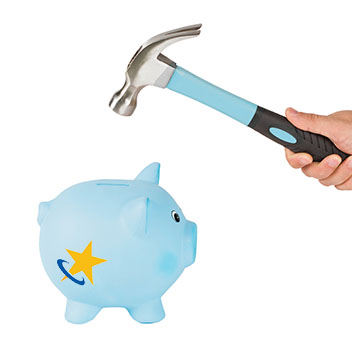The news is full of stories about tariffs trying to bring manufacturing back to America. But in reality, we are a nation of consumers, not manufacturers. The majority of American workers have jobs in public schools, hospitals, restaurants, offices, and stores. We’ve outsourced manufacturing to other areas of the world, which has lowered prices and ultimately enabled us to consume more.
And consume we have – household debt across the U.S. increased $167 billion in the first quarter of 2025, bringing the total to $18.2 trillion. An evolving tech-centered economy has shifted how we spend our money, how we think of ownership, and how much we actually spend.
Take an in-depth look at how we consume goods and services today, plus how it’s possible to shift your mindset and spending to create a better foundation for your financial future.
The Ease and Convenience of Overconsumption
Global manufacturing has made the cost of goods extremely inexpensive. Owning a color television in the 1950s and 1960s was a status symbol; today, big screen televisions with incredible picture quality are cheaper than they ever have been before.
New business models have emerged that keep the cycle of consumption constantly moving. Subscription services, for instance, have become ubiquitous. You probably pay money each month to access movies and music. And it’s not just one fee; most households average four streaming service subscriptions at any given moment.
Amazon’s “Subscribe and Save” service also automates the spending process for items like groceries, dog food, vitamins, and just about anything else. “Buy Now Pay Later” services also make it easy to quickly check out online and spread out payments. It seems convenient at first, but can quickly result in unfavorable outcomes like late fees, overspending, and not fully understanding your real level of debt.
All of these so-called advancements benefit companies the most, while consumers are encouraged to buy more under the guise of lower prices and greater convenience.
5 Tips to Lower Your Consumer Spending
Overspending doesn’t just hurt your wallet – it can also impact your sense of well-being. 40% of American households say they overspend and regret it. Plus, research shows that severe levels of debt lead to poorer health outcomes.
For younger generations in particular, who are less likely to have substantial assets like a house or padded savings accounts, overconsumption makes you more vulnerable in the event of a financial crisis, like losing your job.
So what can you do to turn the tables on overconsumption and financial insecurity? Here are five strategies to shift your spending behaviors and get your money mindset on track.
#1: Find Out What You Actually Spend
Only 45% of Americans between the ages of 18 and 49 say they’re knowledgeable about personal finances. That means over half of this demographic doesn’t know how to manage their money. And if you don’t know what you have, it’s hard to know how much you can spend.
So it’s time to figure it out. Start by making a basic budget that breaks down your monthly income and expenses. Prioritize necessities, like housing, transportation, and insurance. Then look at your spending on non-necessities or discretionary expenses – things you can easily alter how much you spend on them, like eating out, subscriptions services, and clothes.
#2: Figure Out Your Weak Spots
As you build out a budget, review your bank and credit card statements from the last few months. If you have outstanding Buy Now, Pay Later balances, search for each one to track down how much you owe and must pay each week or month.
With all of this information in hand, you’ll start to see trends on where you overspend. Maybe you’re shocked at how many subscription services you pay for, or how much you spend at the grocer store each month. Identify your personal problem areas so you can mindfully cut back, especially if your budget reveals you spend more than you earn.
#3: Go Cold Turkey (Temporarily)
This strategy may sound extreme, but going completely cold turkey on your spending for a set period of time is a great way to reset your spending habits. This doesn’t mean you don’t pay for anything – of course you need to keep on top of your bills and due dates to stay current on all of your accounts.
Instead, create a spending freeze challenge that temporarily eliminates things like entertainment, online shopping, and eating out. If you have a fairly well-stocked kitchen, you could even do a week-long grocery freeze and focus on eating the food you’ve accumulated in your pantry and freezer. As you go through your no-spending challenge, you’ll not only save money, but may also find creative ways to enjoy your free time that doesn’t involve a shopping cart.
#4: Limit Your Social Media Consumption
89% of Gen Z says they compare themselves with others they see online. From watching your favorite influencer’s latest unboxing video to getting targeted ads as you scroll through your feed, spending triggers are all over the internet.
The solution? Cut back on how often you open your social media apps. Set a time limit each day or schedule the moments you choose to log on instead of mindlessly scrolling whenever you have a free moment.
#5: Track Your Progress
It sounds like a lot of work to reduce your spending and become more intentional with how you manage your money. One of the best ways to stay motivated is to set a clear goal and track your progress. Research shows that this is a crucial way to increase your chance of success.
Plus, when you pay attention to small financial achievements over time, you’ll feel empowered to continue your new spending habits.
From Over-Consumer to Disciplined Spender
Revamping your spending habits isn’t about shaming yourself into frugality. Instead, it’s about rethinking why we consume and getting intentional about the purchases that really contribute to our lives. Be mindful of what brings you joy; not only will you experience a greater sense of contentment, you’ll also feel good every time you look at your bank account.







